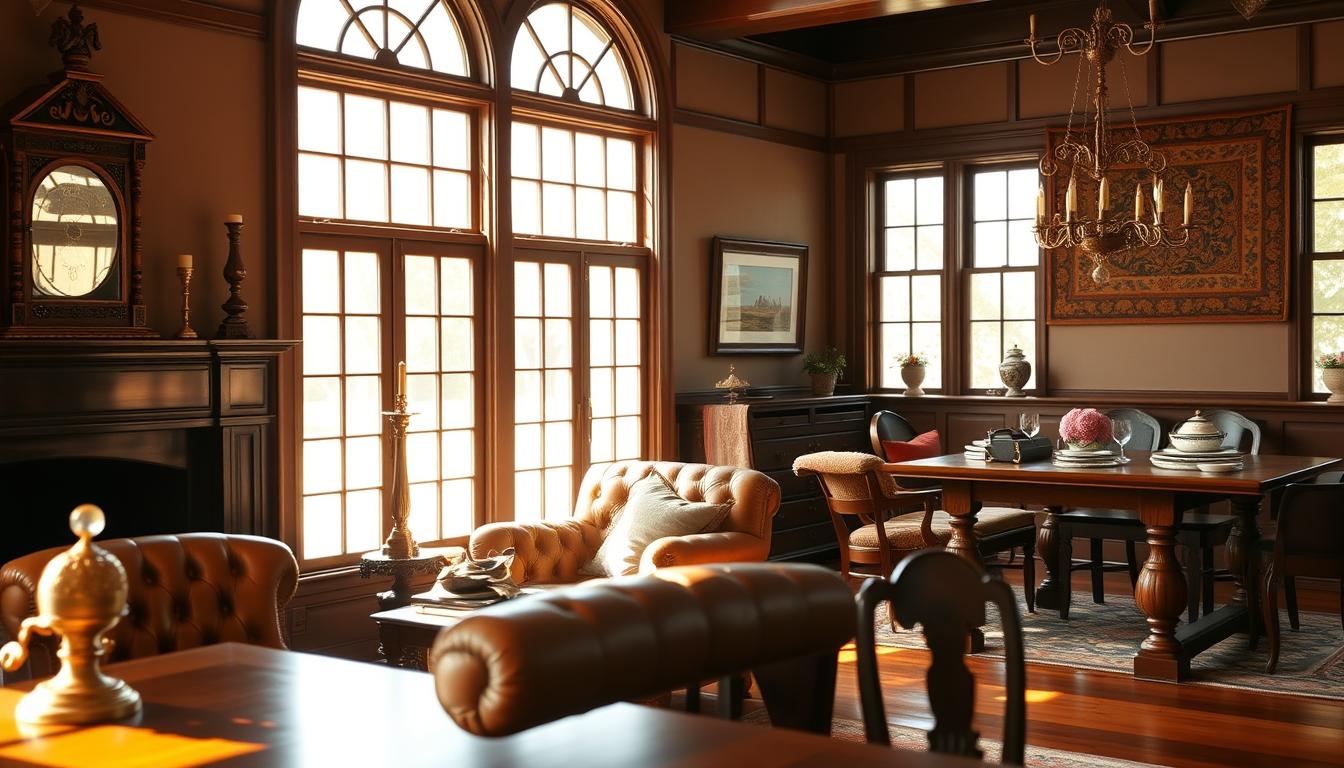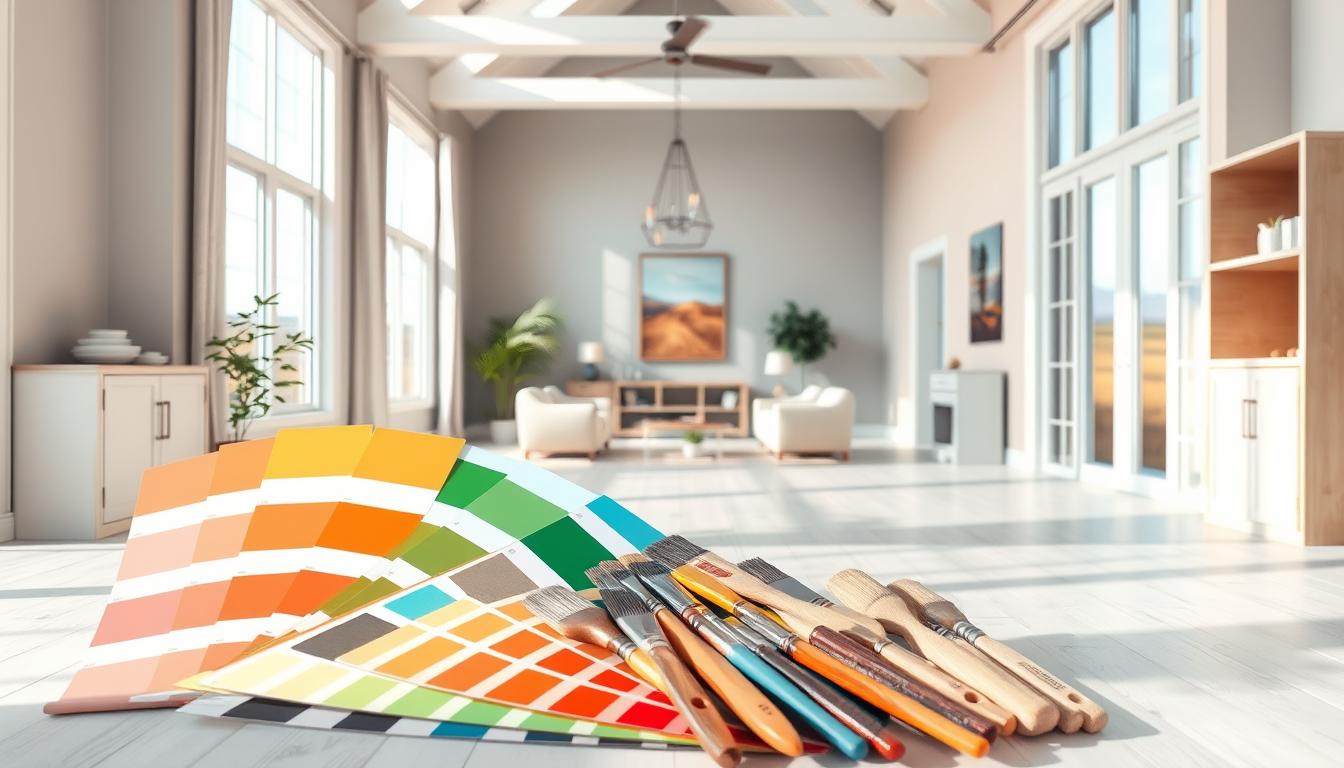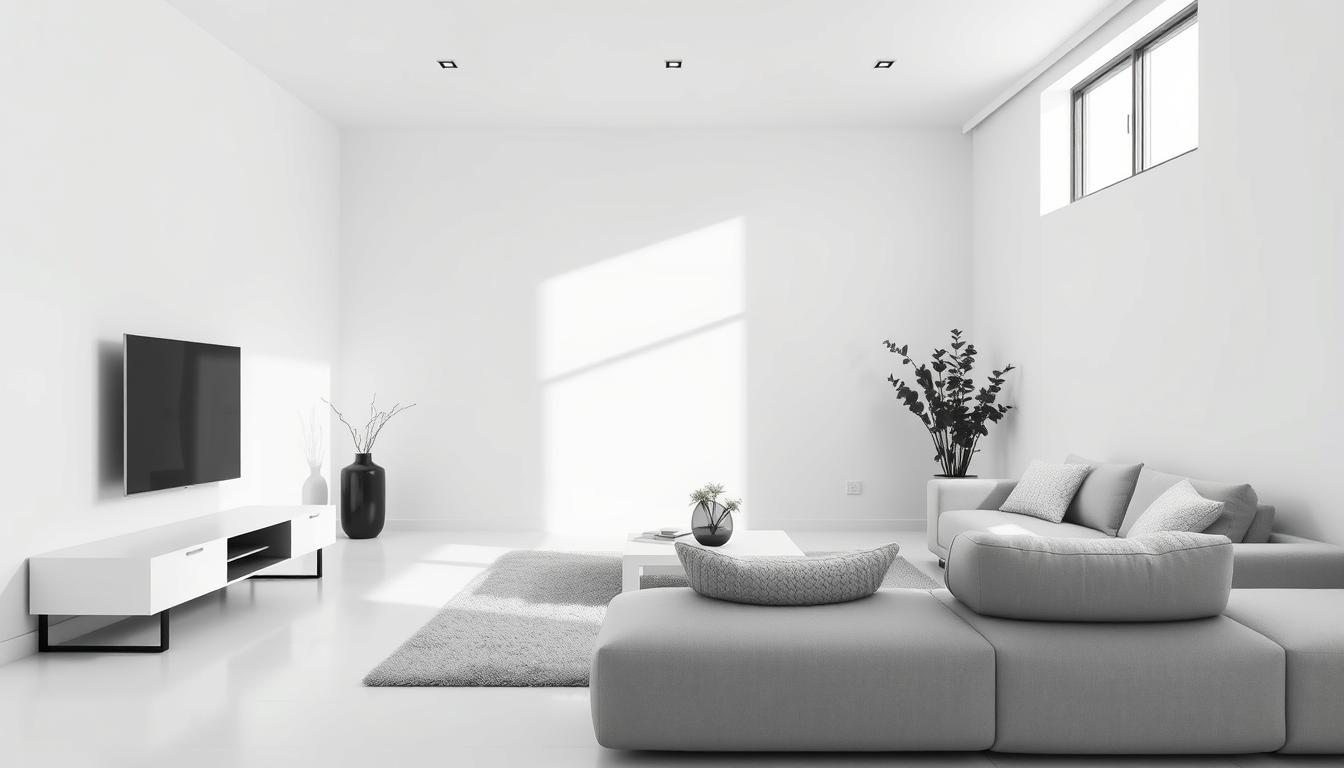Colonial-style homes have been a key part of American architecture for centuries. They bring a timeless elegance and sophistication. Their classic look and ornate details make them a favorite among homeowners.
We’ll show you how to create beautiful colonial-style interiors. You’ll learn about the history of this iconic design movement. Plus, we’ll guide you on picking the right furniture and decor. Our guide is here to help you reach your design dreams.
Key Takeaways
- Understand the history and key characteristics of colonial-style homes
- Learn how to incorporate traditional elements into your modern space
- Discover the essential furniture pieces for a colonial-style interior
- Explore decor ideas that enhance the classic colonial aesthetic
- Gain insights into balancing historic charm with contemporary comfort
The History of Colonial-Style Homes
The story of colonial-style homes is rich and varied. It’s a mix of cultural exchange, architectural innovation, and historical importance. Exploring their history helps us understand early American life and the influences on their homes.
Origins and Influences
Colonial homes started with early European settlers in North America. English, Dutch, Spanish, and French colonizers brought their architectural styles. These styles merged with local and indigenous cultures, creating unique homes.
The New England saltbox house was shaped by English design. The Dutch Colonial style showed Dutch heritage.
| Influence | Characteristics | Notable Features |
|---|---|---|
| English | Symmetrical facades, classical details | Palladian windows, decorative woodwork |
| Dutch | Gabled roofs, flared eaves | Fluted columns, ornate doorways |
| Spanish | Stucco exteriors, tile roofs | Arched windows, ornate ironwork |
Architectural Features
Colonial homes are known for their classic looks. They have symmetrical facades, rectangular shapes, and evenly spaced windows and doors. The colonists used local materials like wood, brick, and stone.
Evolution Over Time
Over time, colonial homes have changed. They went from simple, functional homes to more ornate styles in the 18th century. Colonial house design has always adapted to new needs and tastes.
Today, traditional colonial interiors still inspire many. They offer a timeless elegance that blends past and present.
Key Characteristics of Colonial-Style Interiors
Colonial-style interiors are known for their symmetry, classic materials, and timeless textures. These elements come together to make a space that feels warm and sophisticated.
Symmetry and Balance
Symmetry and balance are key in colonial-style design. This is done by placing furniture and decorations carefully. For example, matching armchairs on either side of a fireplace or identical window treatments on either side of a room create harmony.
To achieve symmetry in your home, try these tips:
- Use pairs of decorative items, such as vases or candlesticks, to create a sense of balance.
- Place furniture in a way that creates a mirror image on either side of a central axis.
- Ensure that window treatments and drapery are consistent in style and length.
Classic Materials and Textures
Classic materials and textures are essential in colonial style. Rich wood tones, luxurious fabrics, and intricate patterns are key. Wooden furniture, like oak, maple, or cherry, is prized for its beauty and durability.
Using different textures adds depth and interest to a room. For instance:
| Material | Texture | Example |
|---|---|---|
| Wood | Smooth, grainy | Oak furniture |
| Fabrics | Soft, intricate patterns | Velvet drapes |
| Metals | Polished, ornate | Brass hardware |
By using these classic materials and textures, you can make a colonial-style interior that feels real and welcoming.
Essential Color Palettes for Colonial Interiors
Choosing the right colors is key to capturing the colonial style. The colors you pick can make your home feel warm and authentic or cold and out of place.
Traditional Neutrals
Traditional neutrals are the heart of colonial interiors. Cream, beige, and soft gray create a calm atmosphere. These colors are timeless and let you add color with furniture and decor.
In vintage colonial decor, you see these colors everywhere. They make the space feel connected and peaceful.
Bold Accent Colors
Bold colors add depth and character to colonial interiors. Rich reds, deep blues, and vibrant greens are common. They add interest and bring history to your space.
Historical Color Choices
Historical colors are crucial in colonial interiors. Colors like ochre, sienna, and umber were made from nature. Using these colors makes your home feel authentic and classic.
When picking colors for your colonial interior, think about the style you want. Mix traditional neutrals, bold colors, and historical choices for a space that feels inviting and true to tradition.
Furniture Selection for Colonial-Style Living
To make a colonial-style interior, picking the right furniture is key. The right pieces can take you back in time. They bring the classic elegance and charm of the colonial era to life.
Period Furniture Pieces
Period furniture is the heart of a colonial-style home. These pieces, known for their detailed carvings and sturdy build, bring authenticity. Some must-haves include:
- Queen Anne chairs, known for their cabriole legs and intricate carvings
- Chippendale-style sofas, featuring ornate details and elegant lines
- Colonial-style dining tables, often made from solid hardwoods like oak or maple
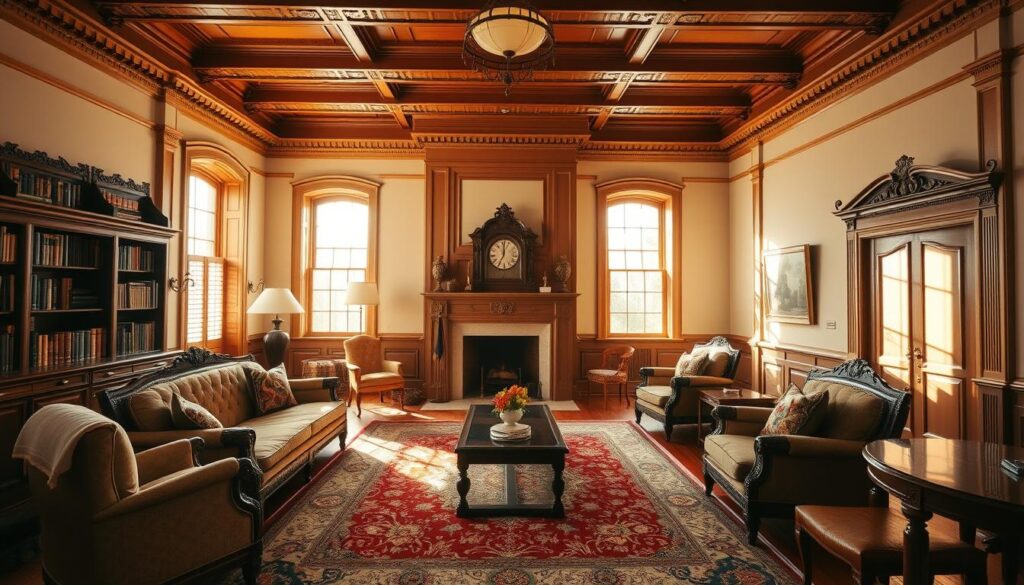
Modern Adaptations
Modern adaptations also have a place in colonial-style interiors. They make the space more functional and comfy for today’s living. Examples include:
- Sofas with clean lines and minimal ornamentation, upholstered in durable, stain-resistant fabrics
- Accent chairs with subtle colonial-inspired details, such as tapered legs or subtle carvings
- Coffee tables made from reclaimed or sustainably sourced wood
The Role of Antiques
Antiques bring a special touch to colonial-style interiors. They offer a peek into the past and add depth. Look for pieces that reflect the colonial era, such as:
| Antique Piece | Description | Era |
|---|---|---|
| Vintage armchair | Ornate carvings, velvet upholstery | Mid-18th century |
| Colonial-style side table | Solid oak construction, subtle molding | Late 17th century |
| Antique mirror | Ornate gold frame, beveled glass | Early 19th century |
By mixing period furniture, modern pieces, and antiques, you can craft a colonial-style interior. It will be both authentic and welcoming.
Flooring Options That Complement Colonial Interiors
The flooring in a colonial-style home is more than just practical. It’s a design element that can make the space shine. When picking flooring, think about how it looks and lasts. This ensures it fits well with the colonial design.
In colonial homes, traditional flooring is often chosen for its real feel and lasting appeal. Hardwood flooring and area rugs are top picks for enhancing colonial interiors.
Timeless Hardwood Options
Hardwood flooring is a key feature in colonial homes, bringing a classic and elegant vibe. Wide-plank hardwood flooring is favored for making rooms feel bigger and matching the colonial style.
Here are some hardwood types that suit colonial interiors well:
- White Oak: It’s durable and light, making it versatile for many colonial designs.
- Red Oak: A timeless choice for colonial homes, it adds warmth and charm.
- Maple: Maple hardwood offers a light, clean, and elegant look.
| Hardwood Type | Color | Durability |
|---|---|---|
| White Oak | Light | High |
| Red Oak | Warm | High |
| Maple | Very Light | Medium |
The Importance of Area Rugs
Area rugs are key in colonial interiors, adding warmth, texture, and interest. Intricately patterned rugs can enhance the colonial look, tying different design elements together.
When picking an area rug for a colonial home, think about these:
- Pattern: Traditional patterns like florals, geometrics, or classic motifs are good choices.
- Material: Wool or silk rugs are great for their durability and luxurious feel.
- Size: Make sure the rug fits well with the room and furniture.
By choosing the right hardwood flooring and area rugs, homeowners can create a colonial interior that’s both authentic and welcoming. Whether you’re fixing up a historic home or building a new one, these options will give you a timeless and elegant look.
Lighting Solutions for a Colonial Aesthetic
To make your colonial-style home warm and inviting, pick lighting that’s both useful and pretty. The right lighting can really change a room’s feel, making it more elegant and classic.
When picking out lighting, think about the style you’re aiming for. For a colonial look, go for traditional pieces like chandeliers and sconces. These not only light up the space but also add to your home’s beauty.
Chandeliers and Pendant Lights
Chandeliers are key in colonial homes because they add grandeur and class. Choose a chandelier that fits your room’s size and your colonial style furniture. A big, fancy chandelier can be a stunning focal point in a big foyer or dining room.
Pendant lights are more subtle but still effective. They’re great for kitchens, dining areas, or hallways for focused lighting. Look for ones with a traditional or vintage look to match your colonial decor.
| Lighting Fixture | Description | Best Used In |
|---|---|---|
| Chandelier | Grand, ornate lighting fixture | Foyer, Dining Room |
| Pendant Light | Focused lighting with a vintage flair | Kitchen, Dining Area, Hallway |
| Wall Sconce | Decorative lighting fixture mounted on walls | Living Room, Bedrooms, Hallway |
Wall Sconces and Table Lamps
Wall sconces are great for adding light to your colonial home. They create a cozy glow in living rooms, bedrooms, and hallways. Choose sconces that match your furniture’s style.
Table lamps are also a smart choice for keeping the colonial look. Pick ones with ornate details or classic shapes to fit your decor.
By using these lighting options, you can make your colonial home warm and welcoming. Choose fixtures that are both useful and beautiful. Feel free to mix styles to get the look you desire.
Textiles and Soft Furnishings in Colonial Design
Textiles and soft furnishings are key in colonial design. They add depth and interest to classic interiors. The right fabrics create a warm, inviting atmosphere typical of colonial homes.
Curtains and Drapes
Curtains and drapes are more than just functional. They’re decorative highlights in colonial interiors. Luxurious fabrics like velvet and silk make drapes grand. Choose fabrics with texture and pattern, like damask or brocade, for your curtains.
Upholstery Choices
Furniture upholstery is crucial in colonial design. The fabric choice greatly affects the look. Striped and floral patterns were common back then. Use historical fabrics or vintage textiles for authenticity.
Decorative Pillows and Throws
Decorative pillows and throws add color and texture. Choose materials and patterns that match your decor. A velvet pillow in a jewel tone adds elegance. A throw with a traditional pattern makes a room cozy.
| Textile | Characteristics | Use in Colonial Design |
|---|---|---|
| Velvet | Luxurious, soft, rich texture | Drapes, upholstery, decorative pillows |
| Lace | Intricate, delicate, often features floral patterns | Curtains, tablecloths, decorative accents |
| Damask | Reversible, woven pattern, often features botanical motifs | Upholstery, drapes, wall hangings |
In conclusion, textiles and soft furnishings are vital in colonial design. They offer many ways to add character and warmth to your home. By choosing fabrics that reflect the era, you can create a beautiful, historically inspired colonial interior.
Incorporating Modern Elements into Colonial Homes
Colonial-style homes can be made better by adding modern touches. This mix makes the space look good and work better.
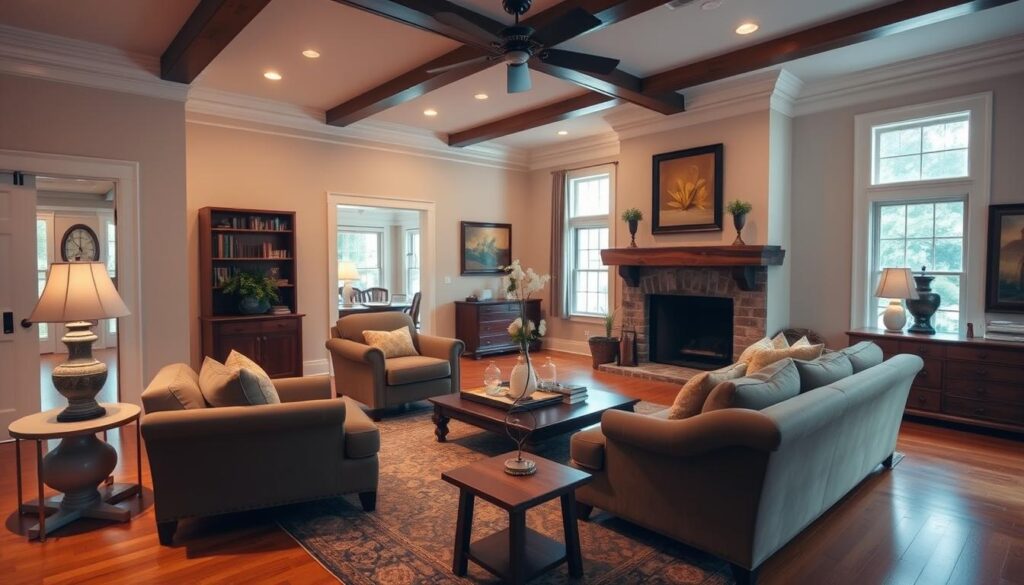
Blending Old and New
Mixing traditional colonial style with modern elements is an art. It’s about keeping the classic feel while adding new touches. For example, combining old furniture with new fabrics or accessories can make a space stand out.
When mixing old and new, think about size and scale. Big modern pieces can overwhelm, while small ones might get lost. Proportion is key to a good mix.
Innovative Design Techniques
Using new design methods is important for mixing modern with colonial style. Try using modern materials in traditional settings. For instance, adding sleek metal or glass to a colonial room can make it modern.
Another way is to give old pieces a new life with modern uses. This adds character and is good for the planet. Creativity is essential in making old things work for today.
To make colonial homes even better, add modern lighting or smart tech. These updates can make the home more comfortable and functional while keeping its classic look.
By carefully adding modern touches to colonial homes, owners get the best of both worlds. This mix of old and new creates a space that’s both beautiful and practical.
Final Touches: Accessories and Decor
As we wrap up our guide to colonial-style interiors, the final touches are key. Accessories and decor add elegance and sophistication. They make a room truly come alive.
Art and Wall Decorations
In colonial design, art and wall decorations are vital. We can pick vintage prints, antique maps, or classic portraits. These add a personal touch and a sense of history.
These pieces not only reflect the colonial era but also enhance the space’s refinement.
Historic Replicas and Accents
To boost the colonial look, we can use historic replicas and accents. Antique furniture reproductions, traditional ceramics, and classic textiles are great choices. They help create a cohesive and authentic colonial home.

